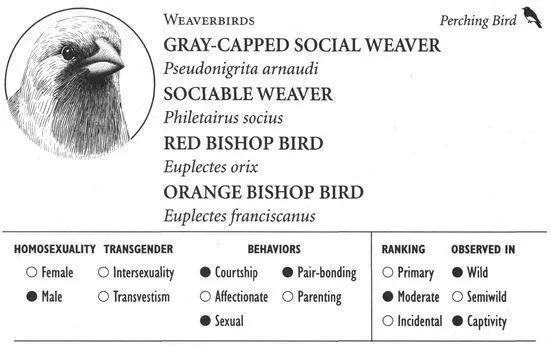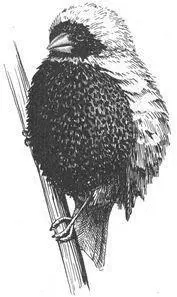Meek, S. B., R. J. Robertson, and P. T. Boag (1994) “Extrapair Paternity and Intraspecific Brood Parasitism in Eastern Bluebirds Revealed by DNA Fingerprinting.” Auk 111:739—44.
*Owen, J. H. (1946) “The Eggs of the Red-backed Shrike.” Oologists’ Record 20:38-43.
*Pinkowski, B.C. (1977) “‘Courtship Feeding’ Attempt Between Two Male Eastern Bluebirds.” Jack-Pine Warbler 55:45—46.
*Pounds, H. E. (1972) “Two Red-backed Shrikes Laying in One Nest.” British Birds 65:357—58.
*Sætre, G.-P., and T. Slagsvold (1993) “Evidence for Sex Recognition from Plumage Color by the Pied Flycatcher, Ficedula hypoleuca.” Animal Behavior 44:293—99.
*Slagsvold, T., and G.-P. Sætre (1991) “Evolution of Plumage Color in Male Pied Flycatchers ( Ficedula hypoleuca ): Evidence for Female Mimicry.” Evolution 45:910—17.
Stanback, M. T., and W. D. Koenig (1992) “Cannibalism in Birds.” In M.A. Elgar and B. J. Crespi, eds., Cannibalism: Ecology and Evolution Among Diverse Taxa, pp. 277-98. Oxford: Oxford University Press.
*Zeleny, L. (1976) The Bluebird: How You Can Help Its Fight for Survival . Bloomington: Indiana University Press.
SPARROWS, BLACKBIRDS, AND CROWS

GRAY-CAPPED SOCIAL WEAVER
IDENTIFICATION: A grayish buff, sparrow-sized bird with a pale gray-white crown. DISTRIBUTION: Northeast Africa. HABITAT: Bush, acacia savanna. STUDY AREA: Olorgesailie National Prehistoric Site, Kenya; subspecies P.a. arnaudi.
SOCIABLE WEAVER
IDENTIFICATION: A drab, sparrowlike bird with brownish gray plumage and a black throat patch. DISTRIBUTION: Southwestern Africa. HABITAT: Scrub, savanna. STUDY AREA: University of California—Los Angeles.
BISHOP BIRDS
IDENTIFICATION: Small, sparrowlike birds with black and brown plumage and various scarlet, red, or reddish orange patches on the chest, nape, crown, and rump. DISTRIBUTION: Sub-Saharan Africa. HABITAT: Moist grassland. STUDY AREAS: Several locations in South Africa, including near Cape Town, Howick, and Bloemfontein; University of Cape Town and University of Bielefeld.
Social Organization
Weaverbirds are named for the intricate—and often colossal—nests they weave. Sociable Weavers build giant condominium-like structures containing many nest chambers; each chamber may house up to 5 birds, while the entire colony can contain as many as 500 birds. Colonies of Gray-capped Social Weavers consist of family groups that each build several hanging nests (one is used as an actual nesting chamber, the others for sleeping). Several groups occupy the same tree, each situated in its own cluster. In both Gray-caps and Sociable Weavers, breeding birds form pair-bonds, and “helper” birds may assist them in their parenting duties. Adult male Bishop Birds establish territories during the breeding season on which they weave elaborate nests and court potential mates. The breeding system of Bishop Birds is polygynous: males mate with numerous females, each of whom lays eggs in one of the nests on his territory, but the male himself does not participate in any parental duties. Outside of the breeding season, Bishop Birds typically socialize in large, often mixed-species flocks.
Description
Behavioral Expression: Male Gray-capped Social Weavers and Sociable Weavers sometimes participate in homosexual copulations. In Gray-caps, birds who participate in same-sex mounting are usually heterosexually paired males, often high-ranking individuals living in the same colony (tree). One male may fly from his home group in the tree to another male’s residence, inviting him to mate by holding his body horizontal, raising his head and tail upward, and drooping and vibrating his wings. The other male then mounts him and proceeds to engage in a complete copulation sequence, probably including cloacal (genital) contact. Mounting between males occurs in Sociable Weavers as well, and about 9 percent of such mounts are also full copulations in which the mounted male crouches, quivers his wings, and moves his tail to the side as the mounting male lowers his tail (probably to achieve genital contact). Usually higher-ranking males mount lower-ranking ones, but all males both mount and are mounted by other males (to varying degrees). In addition, some males appear to form “companionships” with each other. Although males do not generally permit other males to roost with them in their nesting chambers, occasionally two males regularly associate with one another and sleep together in the same nest. This can occur even if one of the males is already paired to a female, in which case all three birds occupy the nest together. The two males may remain together for years, even cooperating in attacking other birds together. Some male “companions” participate in mountings and copulations with each other, but in other cases males do not seem to preferentially engage in sexual behavior with their companion.
On their nesting territories, male Red Bishop Birds court both females and males, the latter usually being younger males who have brown plumage (as do females). Courtship consists of two components: a flying display and a perched display. When a young male appears near his territory, an adult male approaches in a distinctive BUMBLE-FLIGHT, in which he fluffs up all of his plumage and flies with slow wingbeats, resembling a bumble-bee. The bird’s bright red back or epaulet feathers are prominently displayed, and the bumble-flying may be accompanied by singing or a distinctive noise made by his flapping wings. Sometimes males bumble-fly toward another adult male rather than a younger male. After the display flight, the adult male lands near the other male and begins the SWIVEL DISPLAYS: he hops and twists around his perch, approaching the object of his attentions with ruffled plumage and a rattling call—a continuous stream of notes that sounds like zik-zik-zik. No homosexual copulations have been observed in this species in the wild, but heterosexual matings are not commonly seen either. In captivity Orange Bishop Birds—both adults and younger males—sometimes do try to mount younger males (including males of the closely related Golden Bishop Bird, Euplectes afer ). In a homosexual encounter, one male approaches the other while pumping his body up and down and ruffling his feathers, followed by an attempt to copulate with the other male (who usually rejects his advances).
A male Red Bishop Bird displaying fluffed “bumblebee” plumage, used during courtships with same- and opposite-sex partners

Frequency: In Sociable Weavers studied in captivity, as much as three-quarters of all mounting activity is between males, and three out of five full copulations are homosexual. The occurrence of same-sex mounting in wild birds of this species is not known, but its prevalence is probably comparable (especially since heterosexual activity is also apparently infrequent). In one study of wild Gray-capped Social Weavers, all sexual activity that was observed took place between males. In Red Bishops, approximately 6 percent of courtship bumble-flights are directed by one adult male toward another adult male; courtship of younger males probably occurs more often than this.
Читать дальше














